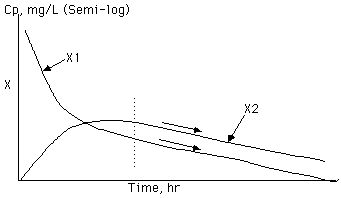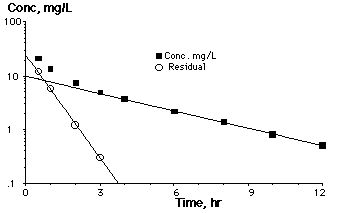




![]()
Equation XIX-2 Apparent Volume of Central Compartment
This parameter is important because it allows the calculation of the highest plasma concentration or Cp0 after an IV bolus administration. This concentration may result in transient toxicity. V1 can also be used in dose calculations.
![]() = Vß
= Vß
Equation XIX-3 Apparent Volume, Varea
Because of the relationship with clearance and ![]() and with V1 and kel this parameter is quite useful in dosing calculations. This parameter can be readily calculated via AUC and
and with V1 and kel this parameter is quite useful in dosing calculations. This parameter can be readily calculated via AUC and ![]() values from the 'raw' data and is therefore commonly quoted.
values from the 'raw' data and is therefore commonly quoted.
![]()
Equation XIX-4 Apparent Volume, Extrapolated
This is the volume value calculated if the distribution phase is ignored. Generally not very useful. However, you may see it used. You will be using this if the distribution phase is ignored. (That is, it is the V calculated using a one compartment model with a two compartment drug).
![]()
Equation XIX-5 Apparent Volume, Steady State
This term relates the total amount of drug in the body at 'steady state' with the concentration in plasma or blood

Figure XIX-8, Plot of X1 (Plasma) and X2 (Tissue) Compartment Concentrations, Showing ‘Steady State’ with Both Lines Parallel
The relationship between volume terms is that:-
Vextrap > Varea > Vss > V1
And for a one compartment model the values for all these parameters are equal.
Table XIX-1 Two Compartment Pharmacokinetics
| Time (hr) | Concentration (mg/L) | Cplate (mg/L) | Residual (mg/L) |
| 0.5 | 20.6 | 8.8 | 11.8 |
| 1 | 13.4 | 7.8 | 5.6 |
| 2 | 7.3 | 6.1 | 1.2 |
| 3 | 5.0 | 4.7 | 0.3 |
| 4 | 3.7 | 3.7 | - |
| 6 | 2.2 | ||
| 8 | 1.4 | ||
| 10 | 0.82 | ||
| 12 | 0.50 |

Figure XIX-9 Plot of Cp versus Time Illustrating the Method of Residuals
The first two columns are the time and plasma concentration which may be collected after IV bolus administration of 500 mg of drug. These data are plotted (n) in Figure XIX-9, above. At longer times, after 4 hours, out to 12 hours the data appears to follow a straight line on semi- log graph paper. Since ![]() >
> ![]() this terminal line is described by B * e-
this terminal line is described by B * e-![]() *t.
*t.
Following it back to t = 0 gives B = 10 mg/L. From the slope of the line [![]() = 0.25 hr-1. Cplate values at early times are shown in column 3 and the residual in column 4. The residual values are plotted (o) also giving a value of A = 25 mg/L and
= 0.25 hr-1. Cplate values at early times are shown in column 3 and the residual in column 4. The residual values are plotted (o) also giving a value of A = 25 mg/L and ![]() = 1.51 hr-1 Note that
= 1.51 hr-1 Note that ![]() /
/![]() = 6, thus these values should be fairly accurate.
= 6, thus these values should be fairly accurate.
B = 10 mg/L, ![]() = (ln 10 - ln 0.5)/12 = 2.996/12 = 0.25 hr-1
= (ln 10 - ln 0.5)/12 = 2.996/12 = 0.25 hr-1
A = 25 mg/L, ![]() = (ln 25 - ln 0.27)/3 = 4.528/3 = 1.51 hr-1
= (ln 25 - ln 0.27)/3 = 4.528/3 = 1.51 hr-1
Therefore Cp = 25 * e-1.51 * t + 10 * e-0.25 * t
We can now calculate the microconstants.
![]()
![]() = 0.61 hr-1
= 0.61 hr-1
![]()
k12 = ![]() +
+ ![]() - k21 - kel
- k21 - kel
= 1.51 + 0.25 - 0.61 - 0.62
= 0.53 hr-1
![]()
The AUC by the trapezoidal rule + Cplast/![]() = 56.3 + 2.0 = 58.3 mg.hr.L-1, [Note the use of
= 56.3 + 2.0 = 58.3 mg.hr.L-1, [Note the use of ![]() ] thus
] thus
![]()
![]()
![]()
Notice that Vextrap > Varea > Vss > V1 [50 > 34.3 > 26.7 > 14.3]
Want more practice with this type of problem!
Copyright 2001-2 David W.A. Bourne




